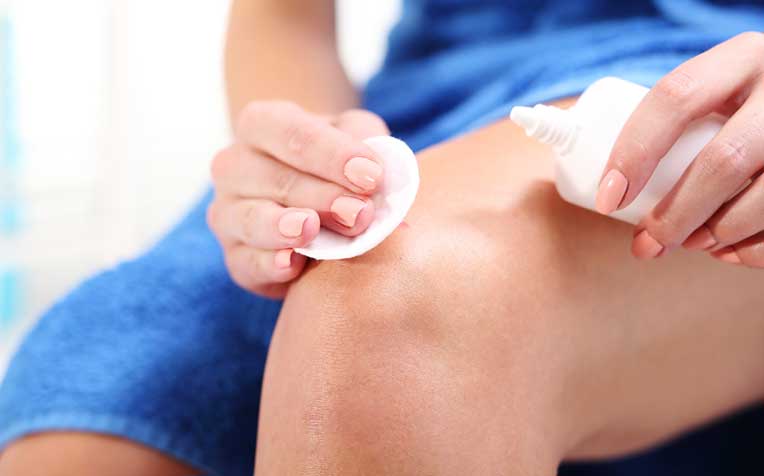It is completely natural for scars to appear after surgical procedures. Tissue that is injured or has undergone some surgical procedure starts to heal, so the formation of a scar is a consequence of these processes. However, although this process is completely natural, many people do not want to live with scars and want to prevent their occurrence as much as possible. We agree that scars can be an aesthetic problem, and fortunately, there are many ways you can approach this problem and prevent (or at least alleviate) the appearance and visibility of scars. In the article below you can read about some of our tips and tricks for reducing scar formation.
Why and how do scars form?

After the surgical procedure, the wound begins to heal and re-form the skin in the affected region in order to protect it from adverse external influences. This process involves the formation of collagen fibers that form the basis of the scar. These fibers stack randomly within the scar tissue, so it becomes very hard and can sometimes even limit the mobility of the surrounding joints, which can be very uncomfortable. Fortunately, with a certain treatment, we can influence how mobile the newly formed tissue will be and how noticeable it will be.
How to reduce scar formation
1. Keep your wound clean

Depending on how deep and delicate the wound is, you will treat it in different ways. After the surgical procedures, the nurse will ensure that the wound is adequately cared for, but when you go home, it is necessary to take care of this yourself. If you want to prevent the formation of scars, it is necessary to treat the wound in the right way from the beginning. Make sure it is always clean and rinse it several times a day with lukewarm water and gentle soap.
2. Make sure the area is moist all the time
As the wound heals and begins to form collagen fibers and scar tissue, it is necessary to keep the region moist at all times. Use occlusives such as Vaseline to ensure that the skin is optimally protected from external influences, but also sufficiently hydrated. When the tissue is sufficiently moisturized, its flexibility increases and the rigidity of the scar and surrounding joints decreases. After applying the occlusive, apply a sticky bandage to the wound or scar tissue to provide the skin with another layer of protection.
3. A good massage goes a long way

Another way you can reduce the density and hardness of the scar and increase its elasticity is to massage it regularly. Don’t be harsh, but try to apply pressure that is pleasing to your skin and that you feel is effective enough. Before the massage, apply body milk or oil with vitamin E, which will help the skin regenerate quickly and optimally hydrate it. If the massage is a little uncomfortable at first, don’t worry: when you get used to it, it will start to please you and you will see results.
It is a good idea to start with very light pressure, and then progress to the one that is firmer, until you reach the maximum pressure that you can withstand without feeling pain. Move the skin in all directions for ten minutes. Repeat the whole process several times a day to maximize results.
Note: There are also electric massagers on the market that you can use to massage your scar tissue, so you don’t have to do it manually.
4. Try supplements that help wound-healing
When you want to reduce the scar after a surgical procedure, it is necessary to approach it from different sides. So it’s a good idea to consider using supplements that help heal wounds and prevent scarring, like the WoundVite, a supplement you can buy on Zennutrients’ webshop. This product was formulated by Devan Patel, a pharmacist from Tampa, Florida.
5. Light exercises

In order to reduce the scar and prevent stiffness of the joints and tendons under the scar tissue, it is a great idea to have some kind of physical activity every day. Of course, when the whole region is still painful and sensitive, we do not advise you to have any kind of exercise. However, when you feel that your body is ready for it and that you have the green light from your doctor, start with slight movements of malice. For a start, bending and stretching the joints is quite enough to increase their mobility, and thus reduce the hardness of the surrounding scar tissue. You can switch to some more complicated exercises over time, but always try to choose the ones that suit your body and do not require too much effort if you are not ready for it.
6. Don’t forget sun protection
Keep in mind that the new scar tissue that forms is very sensitive and that hyperpigmentation can easily appear under the influence of UV rays. So don’t forget to apply sunscreen every day after the scar has healed. We suggest applying SPF30 or higher and reapplying it every two hours to ensure that the skin is completely protected. Do this throughout the first year after the surgery to maximally protect new tissue. If you can, avoid direct exposure of that region to the sun’s rays, especially at the time of day when UV radiation is strongest and most harmful.
Conclusion
After surgery, a wound remains that heals and usually leaves a scar on the skin. Many people are not okay with this and want to remove or at least reduce scar tissue, because it is an aesthetic problem for them. Fortunately, there are a few things you can do to reduce the visibility of the scar. Make sure the wound is clean and protected with occlusives from drying out. Manual or electric massage, light exercises and supplements that help heal wounds are also important. Lastly, do not forget the SPF to prevent the appearance of hyperpigmentation on the scar tissue. With the right approach and regular treatments, you will reduce the visibility of the scar as much as possible.

